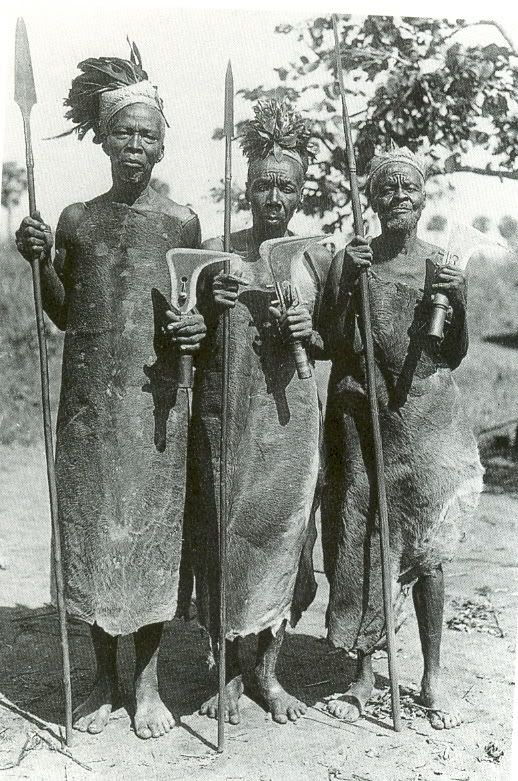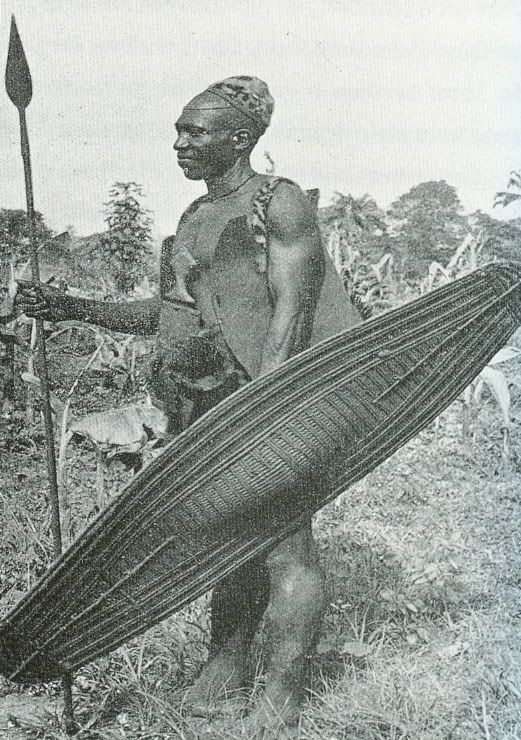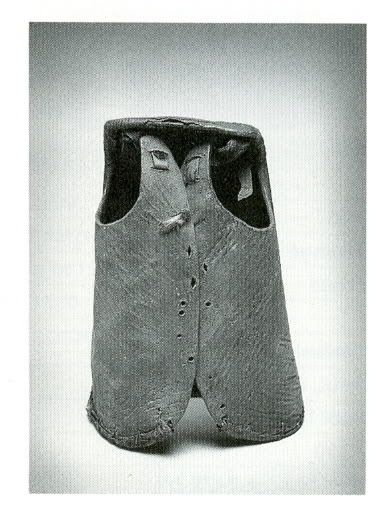
 |
|
|
|
|
#1 |
|
Member
Join Date: Jul 2006
Location: musorian territory
Posts: 415
|
well im interested , the most african weapons ive inspected are either of soft iron or are very poorly hardned,
by african i mean the bantu speeking folk of african not north africa.. did these folk ever use any technique of laminating soft iron and hard steel or anly other more advanced techniques,,.. and how advanced was their temepering and heat treatment... also for that matter does anyone have any fotos of their smithing tools and their anvils .. and how their smiths originaly worked,, the long milti fullered blades woudl take some workand skill to create ,, what sort of anvil was used and what styles of tools.. hammers tongs, ect ect..... also to what exstent was body armour used,, as iron was plentiful in africa how far into africa did its use exstend, i know in etheopia is was comonly used aswell as horse armour as in southern sudan chainmail and helmets and the like were common and was quilted armour and horse armour but south of this ............ ??? |
|
|

|
|
|
#2 |
|
Member
Join Date: Dec 2004
Location: What is still UK
Posts: 5,739
|
We have been here before. You need to look harder and examine more quality pieces. Superb quality can be found. As to layering, I am certain metals of various carbon content were mixed when available or needed but any visual signs of layering that I have found just seem to be incidental to forging the work. I have big macho spears all the way down to small blades like the old safety razor blades. When I have time I will post pics. Looking at some work, before the introduction of trade steel. There is the most ingenious use of form and fullering to achieve strength with minimum use of steel, if not rare, then certainly expensive and hard won. A different kind of bigness.

|
|
|

|
|
|
#3 |
|
Member
Join Date: Dec 2004
Location: What is still UK
Posts: 5,739
|
ausjulius, you might find this stuff interesting. This book was printed 1963 then the outlook on what Africa could produce was a little different from today. Every other possible source of origin is suggested but also questioned. There is no open mention of an African origin, however I read that this is an open invitation for contemporary collectors and students to take further. It is interesting that the weapons of Persian form and etched with script are made in Africa. Some infidel weapon forms from the forests of central Africa have indeed be Islamized by such decoration. Read these extracts from "Nigerian Panoply arms and armour of the Northern Region" We are looking at Islamic city states not mud hut villages.
Last edited by Tim Simmons; 13th June 2008 at 06:48 PM. Reason: spelling |
|
|

|
|
|
#4 |
|
(deceased)
Join Date: Dec 2004
Location: East Coast USA
Posts: 3,191
|
ausjulius
You must realize that if one does not wear too much more than a loin cloth and carries a cow hide shield than Iron spears and daggers do not need to be tempered to a high hardness do accomplish their intended work.   Lew |
|
|

|
|
|
#5 |
|
Member
Join Date: Dec 2004
Location: What is still UK
Posts: 5,739
|
If you down load these pics and examine magnified. You will see a form of layering. Believe me this is tempered. I am sure that if I were to etch the surface, patterns would appear but only incidental. The spine of the spear is over 1cm thick. I think one has to develop more of an eye with African pieces
 
Last edited by Tim Simmons; 13th June 2008 at 06:55 PM. Reason: spelling |
|
|

|
|
|
#6 |
|
Member
Join Date: Dec 2004
Location: Sint-Amandsberg (near Ghent, Belgium)
Posts: 830
|
I agree what Lew says. In Central Africa it would have been very difficult to wear metal protective gear.
In 'Dodelijk Mooi' (Deadly Beauty) I found some examples of Central African armour. First pic shows some Mangbetu warrior (photograph taken in 1936). They wear some kind of leather apron as protection.  Next is a Ngiri warrior from Congo in full battledress (photograph taken in 1916). The second picture shows his body armour.   Third is a kind of helmet from the Mbala in Congo :  Last, but not least are som Mali horsemen with their horses in full armour. This armour consist of thick cotton clothing.  All this would surely protect against spears, arrows and other bladed weapons. |
|
|

|
|
|
#7 | |
|
Member
Join Date: Jul 2006
Location: musorian territory
Posts: 415
|
Quote:
or the celts, many didnt wear much atal when they fought,,,.. but they had tempering and lamination techniques equial to those used in the middle ages.. as to the heat,, india is as hot or hotter than africa,, and ... welly ou can see armour is very common there... and has always been etheopia is not arctic nation as plate and chaim armour had exsisted ther ein abundance for a very lond time , yemen and oman ,, body armour was very common up untill the late 17th centuary.. heat and armour dont have much relation.... metal working skill and armour do. steel availability does.. warefare techniques do.. so this i find facinating.. the quilted armour comes form the middle east and arived very late.. the crude untreated leather vests ive observed before, but this is far more primative than the armour used in the pacific for exsample, which was realt quite advanced........... and rememebr in the pacific they lacked even leather let alone metal this realy makes me wounder if there was any form of metal brestplate used..... or any other for of armour or any metalic helmets.. gauntlets ect ect.. it so odd that people had mastered iron productin so well but never advanced the metal craft further. i do wounder has there been much research into iron use in africa, i wounder how long iron weapons have been made in large numbers there, and how long swords have exsisted there.. and what the previous styles were like.. and if bronze or copper were used before that to produce swords ..... i wounder how long these styles have exsisted and what sort of swords were before, . |
|
|
|

|
|
|
#8 |
|
(deceased)
Join Date: Dec 2004
Location: East Coast USA
Posts: 3,191
|
[QUOTE=ausjulius]come now tell that to the dayaks... :P
or the celts, many didnt wear much atal when they fought,,,.. but they had tempering and lamination techniques equial to those used in the middle ages it so odd that people had mastered iron productin so well but never advanced the metal craft further. ausjulius From what I know the Celts and middle age swords were mostly spring tempered to between 45-50 Rockwell and the laminated blades consisted of a central core which had an outer edge of harder steel welded around the core. I saw no evidence of a differential heat treat or the use of san mai or clay tempering techniques as found in Asian blades. You also must take into consideration that there was a great deal of trade going on of ideas and goods between India,Persia,Central Asia,China and North Africa which may not have reached Central Africa the Congo and South Africa. So the Bantu smiths forged blades in very primitive forges consisting of a hole in the ground a basic bellows and a stone anvil. What they produced worked just fine for their type of warfare and there was no need to fix what was not broken. There was an arms race of in Asia and MidEast and Europe that atributed to the evolution of better arms and manufacturing techniques which in the end produced superior steel bladed weapons which now we see today. As far as the use of armor is concerned the Mid East was hot and dry as was Rhajistan in India so wearing metal armor or chail mail may not have presented as much as a problem as in central Africa were you can have the same heat but with 90 percent plus humidity and the humidity would not only kill you faster via heat stroke but would cause the armor to rust faster. Lew Last edited by LOUIEBLADES; 14th June 2008 at 03:18 PM. |
|
|

|
|
|
#9 | |
|
Member
Join Date: Jul 2006
Location: musorian territory
Posts: 415
|
Quote:
i was after indiginous invention. and styles. otherwise one could show a picture of a cutlas or machete from the 17th centuary yukatan and say it was made by mayan culture becasue the person who wore it or forged it was of mayan decent,,,,.. the item still could nto be considered native,, or more correctly native to the previous culture, what im interested in in amrour purly native to africa, it appers that the central western part of africa had a unique style in making their weapons, and a unique concept in how they should be used and what for, and so i am facinated as to how they made them and how the technique evolved. as normaly where more and more metal working is undertaken in larger amounts, skill increases and technique forms more precisly.. and so the understanding of steel increases and is transfered to the next smith, in areas where many many tools or weapons are produced that are alike you get an increase in the quality as each smith compeats to sell his work and each user wishes his item to be more superior than the next mans.. s you can get a simple golok,, with a poorly treated blade and a crude grip.. and you can get a fine one made of folded steel with a ivory grip and exsotic wood on the sheath.... ... ive noticed that most african knives had large flaws in the blade, and as i dont know what type of smithing techniques they sued i woudl hazard a guess in that they used a stone anvil and proably very simple tools.. still to put so meany fullers into the itmes would take quite some work without good tools.. but realy the hardening if found is mostly very soft, or none atall, all antique african weaponrt ive found is no softer than a normal machete or other spring hardened item, 45 rockwell or less.. and the blade finish also interests me , was there an ability to polish the blades atall as ive never seen any actualy polish on the.. and for that matter did the people possess any rotary grinding device? or did these only come with the arrival of europeans.. this area of thins is quite of interest as it is a large area and these items were still made in mos recent times, and realy in huge amounts...... as when you look at the numbers of soliders sepcific african cheifdoms had under them.. they are quite large. 5000 or 10000 or more.. and most of these no doubt woudl have had some hand weapons aside from spears.. |
|
|
|

|
|
|
#10 | |
|
Member
Join Date: Jul 2008
Posts: 2
|
Greetings, fellow lovers of world culture. I'm new to this forum, however, not new to the topic. I am a blacksmith who specializes in recreations of African weapons and the owner of African Arms.
Let's see...where do I begin?  I'll start with the mail shirt posted earlier on this thread. It's ceremonial.  A common mistake made by many when viewing mail of this type is to assume that it's functional. Mail of this caliber was never meant to see combat. This mail shirt is a talismanic ceremonial expression. A tell tale sign of this are the Arabic inscriptions placed on every single link. It is a tribute and a sacrifice of one's time and effort to show their religious devotion and was worn on ceremonial and festive occasions. Real functional combat mail worn by the Sudanese was much more closely linked. Quote:
 Also, the Romans would have no mail armor if were not for their encounters with the Gauls who they considered to be of another race in the modern sense of the word. Are we to say that mail armor is not Roman? As for your example of the 17th century Yucatan cutlass, ausjulius, this would not apply to Sudanese mail armor. For these warriors wore this armor in the middle ages and birthed kingdoms with it. It is not as if this armor was worn centuries later at a time when their descendents were no longer referred to as Sudanese which would have to be the case in your example of the Mayan descendent from the Yucatan. |
|
|
|

|
 |
|
|